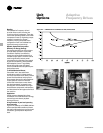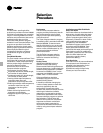
CTV-PRC007-EN24
Simultaneous Heating and Cooling
The Trane Heat Recovery CenTraVac
™
chiller is an excellent choice for
applications requiring simultaneous
heating and cooling. CenTraVac models
save energy by recovering heat normally
rejected to the atmosphere and putting
that energy to use providing space
heating, building hot water or process
hot water. This heat is provided at a
fraction of conventional heating systems
cost. A heat recovery CenTraVac can
provide 95 to 120°F hot water.
An advanced computer selection
program chooses a heat recovery
condenser to match your needs. Two
separate condenser shells are used with
the Heat Recovery CenTraVac chiller. The
heating circuit and cooling tower circuit
are separate, preventing cross
Figure O-8 — Refrigerant Pressure Difference
Figure O-7 — Typical Operating Cycles
System
Options
Heat Recovery
(Cont.)
contamination. Refrigerant gas from the
compressor flows into both condenser
shells allowing heat rejection to one or
both condenser water circuits.
The reliability of the Heat Recovery
CenTraVac chiller has been proven in
installations around the world. This
option is completely factory packaged.
To further reduce the system energy
requirements, the following design
considerations should be incorporated
into any heat recovery system.
System Design Considerations
Heating Water Temperatures and
Control — It is always desirable to use as
low a heating water temperature as the
application allows. Experience has
shown that a design heating water
temperature of 105 to 110°F can satisfy
most heating requirements. Lower
heating water temperatures increase the
chiller operating efficiency both in the
heating mode and in the cooling mode.
In general, the heat recovery power
consumption will increase 7 to 14
percent for every 10°F increase in the
design heating water temperature. A
consideration which is just as important
as the design heating water temperature
is how that temperature is controlled. In
most cases, the heating water
temperature control should be designed
to maintain the return heating water
temperature. By allowing the supply
water temperature to float, the mean
water temperature in the system drops
as the chiller load decreases and less
heat is rejected to the condenser. As the
mean heating water temperature drops,
so does the refrigerant condensing
temperature and pressure difference
which the compressor is required to
produce at part load. This increases the
unloading range of the compressor.
When the supply heating water
temperature to the building system is
maintained and the return heating water
temperature to the condenser is allowed
to float, the mean heating water
temperature actually rises as the chiller
load decreases and less heat is rejected
to the condenser. As Figure
O-8 illustrates, when the compressor
unloads, the pressure difference that it
must oppose to prevent surging remains
essentially the same, while the
compressor’s capability to handle the
pressure difference decreases.
Therefore, the unit’s capability to unload
without the use of hot gas bypass is
reduced.
Hot gas bypass artificially increases the
load on the compressor (cfm of
refrigerant gas) by diverting refrigerant
gas from the condenser back to the
compressor. Although hot gas bypass
increases the unit’s power consumption
by forcing the compressor to pump
more refrigerant gas, it will increase the
heat available to recover for those
applications where significant heating
loads remain as the cooling load
decreases.


















